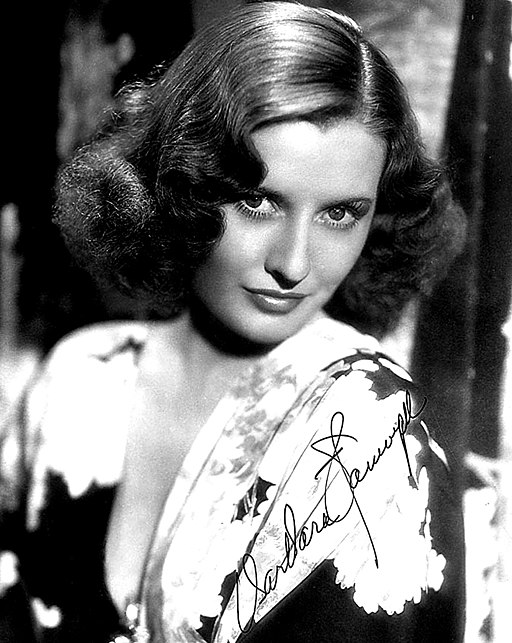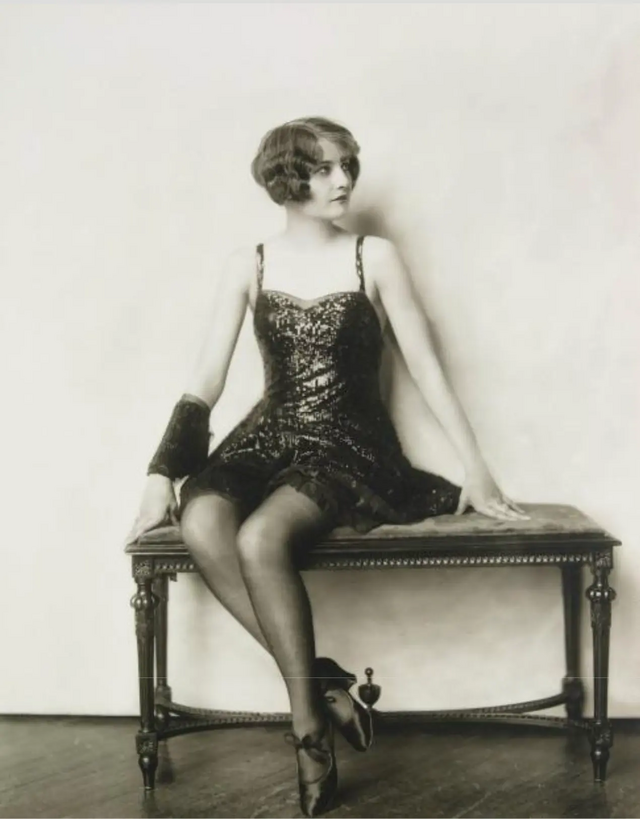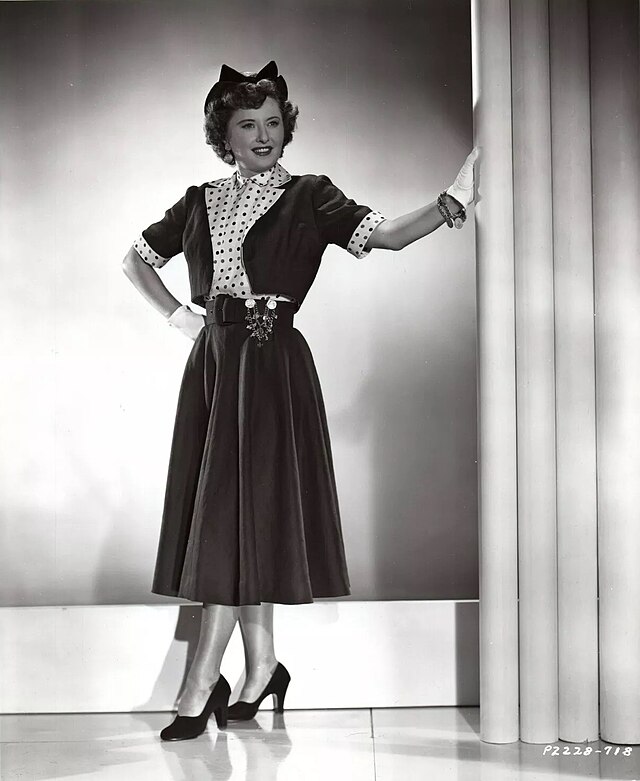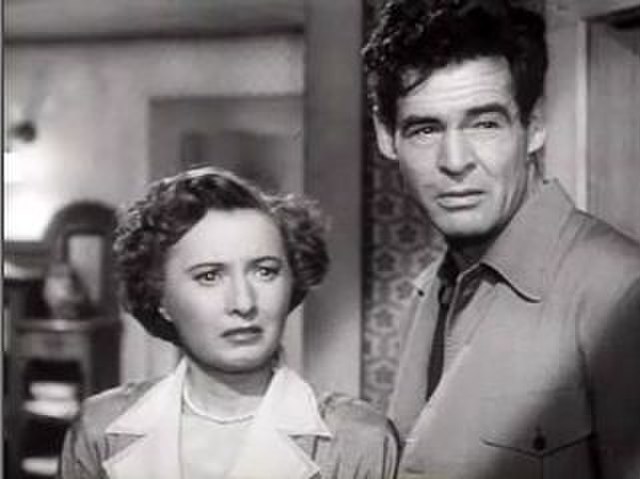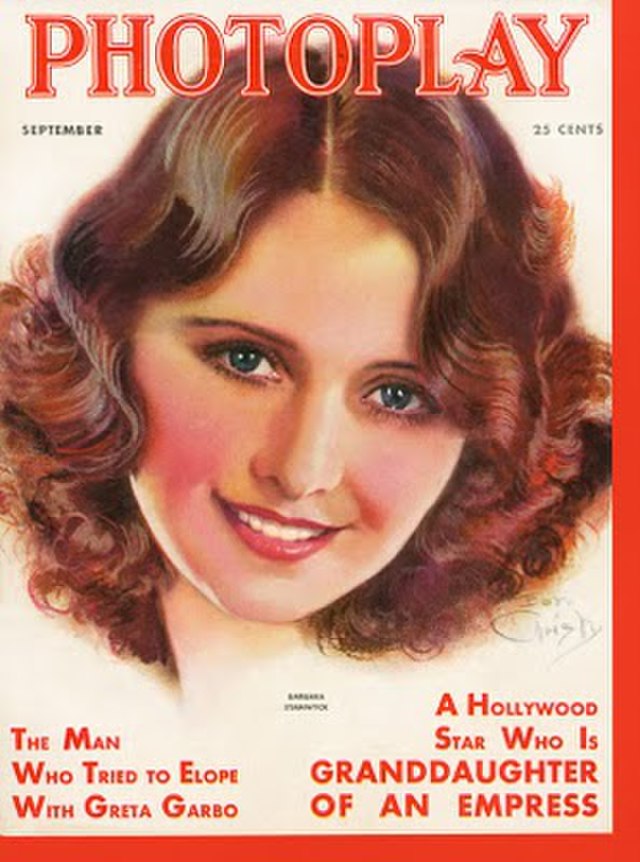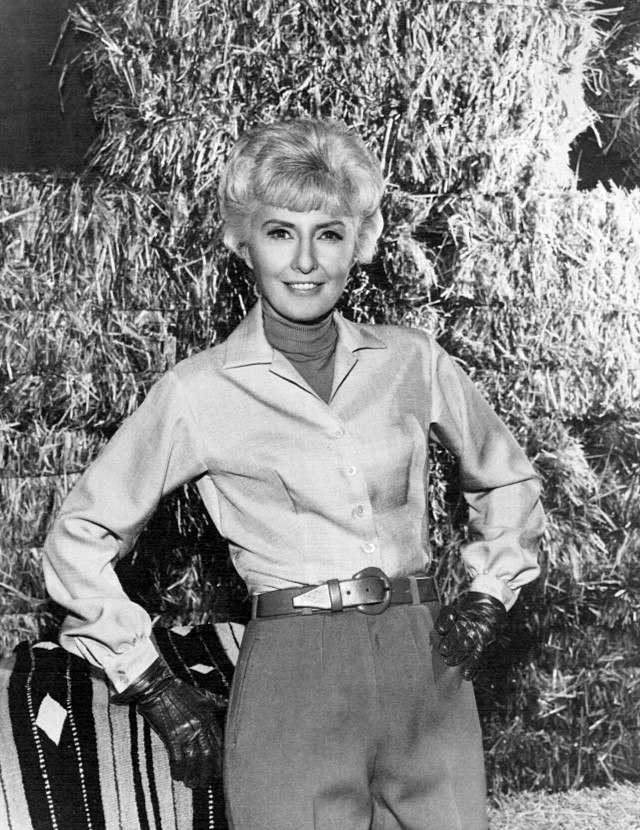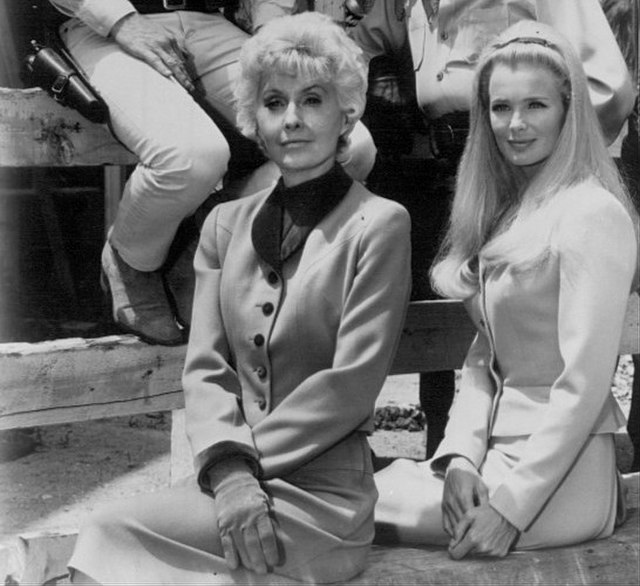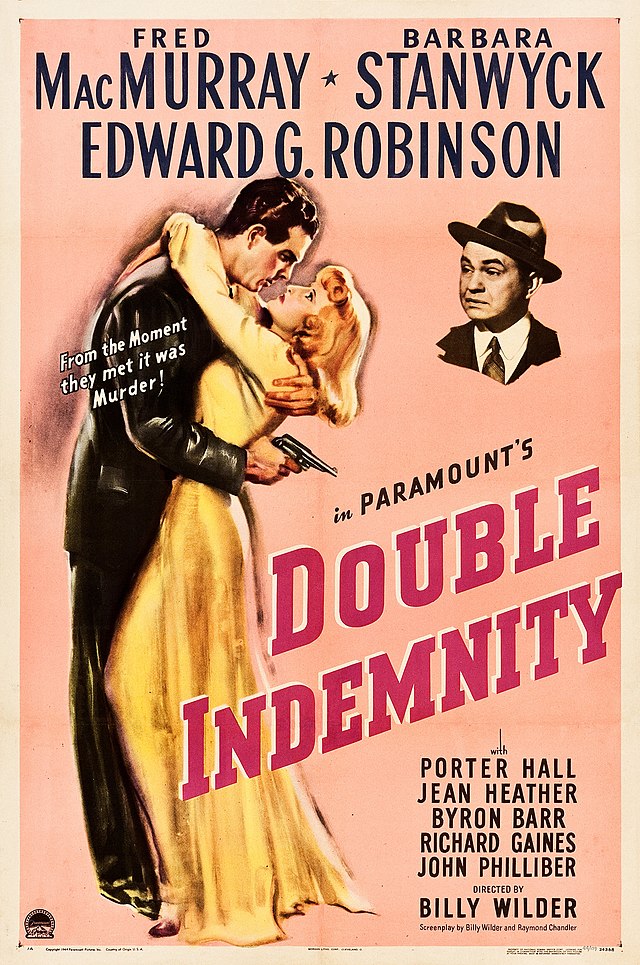Barbara Stanwyck
back| Full Name | Ruby Catherine Stevens |
| Stage Name | Barbara Stanwyck |
| Born | July 16, 1907 |
| Birthplace | Brooklyn, New York, USA |
| Died | January 20, 1990 |
| Buried | Cremated; ashes scattered in Lone Pine, California |
| Married to | Frank Fay (m. 1928; div. 1935) - Robert Taylor (m. 1939; div. 1951) |
| Children | Dion Anthony |
| Notable films | Stella Dallas (1937) - Double Indemnity (1944) - Ball of Fire (1941) - Meet John Doe (1941) - Sorry, Wrong Number (1948) - Lady Eve (1941) |
Barbara Stanwyck
Missy Stanwyck
Barbara Stanwyck rose from a troubled childhood to become one of Hollywood’s most versatile and respected actresses. She began her career in theater and transitioned to film in the late 1920s.
Known for her naturalism and emotional depth, she starred in classics like Stella Dallas (1937), Double Indemnity (1944), and Christmas in Connecticut (1945).
She successfully transitioned to television, winning three Emmy Awards for The Barbara Stanwyck Show, The Big Valley, and The Thorn Birds.
Related
Barbara Stanwyck (1907 – 1990)
Biography, Movie Career and her Movies
Barbara Stanwyck was born Ruby Catherine Stevens on July 16, 1907, in Brooklyn, New York. She was the fifth and youngest child of Catherine Ann (née McPhee) and Byron E. Stevens. Tragedy struck early in her life when her mother died in a streetcar accident, and her father abandoned the family. Consequently, Ruby and her siblings were raised in foster homes and by older sister Mildred.
Career Beginnings
Stanwyck's career began in the theater. She worked as a chorus girl and performed in vaudeville before moving to Broadway. She adopted the stage name Barbara Stanwyck and gained her first major role in the play "Burlesque" in 1927. Her performance caught the attention of Hollywood, leading to a contract with Columbia Pictures.
Rise to Stardom
Stanwyck's film career took off with the success of "Ladies of Leisure" (1930). She quickly became known for her versatility and strong screen presence. Over the next decade, she starred in a string of successful films, including "Baby Face" (1933), "Annie Oakley" (1935), and "Stella Dallas" (1937). Her performance in "Stella Dallas" earned her the first of four Academy Award nominations for Best Actress.
Peak Career
The 1940s saw Stanwyck at the height of her career. She starred in numerous classic films, such as "The Lady Eve" (1941), "Ball of Fire" (1941), and "Double Indemnity" (1944). Her role in "Double Indemnity," a quintessential film noir directed by Billy Wilder, remains one of her most iconic performances.
Later Career and Television
In the 1950s, Stanwyck transitioned to television. She starred in the successful series "The Barbara Stanwyck Show" (1960-1961), for which she won an Emmy Award. She continued to work in television throughout the 1960s and 1970s, earning additional acclaim for her roles in "The Big Valley" (1965-1969) and "The Thorn Birds" (1983).
Personal Life
Barbara Stanwyck married actor Frank Fay in 1928. They adopted a son, Dion Anthony "Tony" Fay. However, the marriage was troubled and ended in divorce in 1935. Her second marriage was to actor Robert Taylor in 1939, which also ended in divorce in 1951. Stanwyck never remarried after her divorce from Taylor and lived the rest of her life in relative seclusion.
Death and Legacy
Barbara Stanwyck passed away on January 20, 1990, due to congestive heart failure and chronic obstructive pulmonary disease. She was 82 years old. Her ashes were scattered in Lone Pine, California, a location she loved.
Stanwyck is remembered as one of Hollywood's most talented and versatile actresses. She appeared in over 80 films, leaving a legacy of strong, memorable performances. Her work continues to be celebrated, and she remains an iconic figure in the history of American cinema.
Interview with Barbara Stanwyck from 1947:
Commanding Acting Style:
Stanwyck's performances are often noted for their naturalism. She brought a raw and unfiltered authenticity to her roles, making her characters feel real and relatable. Whether playing a working-class heroine or a high-society lady, Stanwyck had the uncanny ability to imbue her characters with genuine human emotions and reactions. Her portrayal of vulnerability and strength was always nuanced and never overdone, allowing audiences to connect deeply with her characters.
Versatility and Range
One of Stanwyck’s most remarkable qualities as an actress was her versatility. She effortlessly transitioned between genres, including melodrama, film noir, screwball comedy, and westerns. In films like Stella Dallas, she portrayed a self-sacrificing mother with heartbreaking sincerity, while in Double Indemnity, she played the quintessential femme fatale with a chilling, seductive edge. This range showcased her ability to adapt her performance style to suit the demands of each role, whether it required dramatic intensity, comedic timing, or a combination of both.
Commanding Presence
Stanwyck had a commanding screen presence that drew viewers in and held their attention. Her strong, expressive eyes and the ability to convey complex emotions through subtle facial expressions and body language made her performances magnetic. She could dominate a scene with a mere glance or a slight change in posture, demonstrating her skill in using physicality to enhance her acting.
Emotional Depth and Complexity
Stanwyck was adept at portraying complex, multi-dimensional characters. She often took on roles that required her to navigate a wide range of emotions, from joy and love to despair and anger. Her ability to convey inner turmoil and conflict added layers to her characters, making them more compelling and realistic. In Sorry, Wrong Number, for example, she delivered a gripping performance as a bedridden woman unraveling a murder plot, capturing the character's fear, desperation, and determination.
Strong, Independent Women
Throughout her career, Stanwyck often portrayed strong, independent women who were ahead of their time. These characters were resilient, resourceful, and unapologetically themselves. In Ball of Fire, she played a savvy nightclub singer who outsmarts a group of professors, while in The Lady Eve, she was a con artist who matched wits with a wealthy heir. Stanwyck’s ability to embody these empowered female characters contributed to her enduring legacy as a pioneering actress.
Subtlety and Understatement
Unlike some of her contemporaries, Stanwyck’s acting style was often characterized by subtlety and understatement. She avoided melodramatic flourishes, opting instead for a more restrained and measured approach. This understated style made her performances feel more authentic and grounded, allowing the audience to become more invested in her characters' journeys.
Strong Work Ethic and Professionalism
Stanwyck was known for her strong work ethic and professionalism on set. She approached each role with dedication and meticulous preparation, ensuring that she delivered the best possible performance. This commitment to her craft earned her the respect of her peers and contributed to her consistent excellence across a long and varied career.
In summary, Barbara Stanwyck's acting style was marked by its authenticity, versatility, and emotional depth. She brought a commanding presence to the screen, adeptly portrayed complex characters, and often represented strong, independent women. Her subtle, nuanced performances and professional dedication made her one of the most respected and enduring actresses in Hollywood history.
Memorable Quotes:
On Acting and Her Career
- "Egotism – usually just a case of mistaken nonentity."
Stanwyck often spoke about the importance of staying grounded and avoiding egotism in the acting profession.
- "Career is too pompous a word. It was a job, and I have always felt privileged to be paid for doing what I love doing."
This quote highlights her humility and passion for acting.
- "I want to go on until they have to shoot me."
Stanwyck's dedication to her craft was unwavering, and she expressed a desire to continue acting as long as possible.
- "I couldn't remember my name for weeks. I'd be at the theater and hear them calling, 'Miss Stanwyck, Miss Stanwyck,' and I'd think, 'Where is that dame? Why doesn't she answer?'"
Reflecting on her transition from Ruby Catherine Stevens to Barbara Stanwyck, this quote shows her humor and adjustment to her stage name.
On Life and Personal Beliefs
- "My only problem is finding a way to play my 40th fallen woman in a different way than my 39th."
Stanwyck often played strong, complex female characters, and she joked about finding new ways to portray similar roles.
- "I never wanted to be a movie star. I wanted to be an actress."
This quote underscores her focus on the craft of acting rather than the fame associated with it.
- "The more you kick something that's dead, the worse it smells."
A reflection on moving on from the past and not dwelling on negative experiences.
Memorable Lines from Her Films
- "We're both rotten." — Walter Neff: "Only you're a little more rotten." (Double Indemnity)
One of her most famous lines as Phyllis Dietrichson in the classic film noir, showcasing her character's complex morality.
- "You can take all the bad shots, but you need good luck for the last." (The Lady Eve)
A line from her role as Jean Harrington, reflecting the blend of luck and skill required in life and con artistry.
- "I'd hate to take a bite out of you. You're a cookie full of arsenic." (Ball of Fire)
As Sugarpuss O'Shea, this line captures her character's sharp wit and charm.
What others said about Barbara Standwyck:
Actors and Actresses
- William Holden:
"When you’re with her, you’re always aware of the fact that here is a really living, intelligent, and sensitive human being. She’s not acting, she’s just living the part she’s playing."
- Fred MacMurray:
"Stanwyck and I enjoyed working together. But the truth is, she was the real deal, a real professional. She gave everything to her roles and made it easy for her co-stars."
- Henry Fonda:
"Barbara was the consummate professional, always prepared, always brilliant. Working with her was a lesson in dedication and excellence."
- William Wellman (Director):
"Stanwyck is a director’s dream. She works without make-up, cuts her hair, walks around in clothes you wouldn’t believe – and she never complains. She’s the best."
Directors and Producers
- Frank Capra:
"She was a natural. She never seemed to be acting. Whatever the part, she became that woman. To me, that was her great gift."
- Cecil B. DeMille:
"Barbara Stanwyck was a great actress, but she was even a greater human being. She was the most selfless of all the stars I have ever met."
Critics and Historians
- David Thomson (Film Critic):
"Stanwyck was a pioneer, playing women who were tough, realistic, and ahead of their time. She brought a certain authenticity to her roles that few could match."
- Molly Haskell (Film Critic):
"She could handle any role with grace and dignity, from melodramas to screwball comedies. Her versatility and depth were unparalleled."
- James Robert Parish (Film Historian):
"Barbara Stanwyck was one of the most talented and respected actresses of her era. Her ability to convey deep emotion with subtlety and strength made her stand out in Hollywood."
Fellow Professionals
- Robert Wagner (Actor):
"She had this incredible ability to be both the strongest person in the room and the most vulnerable. It’s something you don’t see often, and it’s what made her performances so memorable."
- Joan Crawford (Actress):
"Barbara and I were contemporaries, and I always admired her work. She had a presence and a talent that were unmistakable. Hollywood was lucky to have her."
Public Perception
- Bette Davis (Actress):
"In an industry that prizes youth and beauty, Stanwyck was a testament to talent and tenacity. She showed that skill and hard work could make you a star, regardless of age."
- Kirk Douglas (Actor):
"She had a style and a charisma that were unique. Watching her work was like seeing a master class in acting."
Awards and Recognition:
Academy Awards (Oscars)
- Nominations:
1938: Best Actress for Stella Dallas
1942: Best Actress for Ball of Fire
1945: Best Actress for Double Indemnity
1949: Best Actress for Sorry, Wrong Number
- Honorary Award:
1982: Honorary Academy Award for her "superlative creativity and unique contribution to the art of screen acting."
Golden Globe Awards
- Wins:
1984: Best Supporting Actress – Television for The Thorn Birds
- Nominations:
1966: Best TV Star – Female for The Big Valley
Emmy Awards
- Wins:
1961: Outstanding Performance by an Actress in a Series (Lead or Support) for The Barbara Stanwyck Show
1966: Outstanding Continued Performance by an Actress in a Leading Role in a Dramatic Series for The Big Valley
1983: Outstanding Lead Actress in a Limited Series or a Special for The Thorn Birds
- Nominations:
1967: Outstanding Continued Performance by an Actress in a Leading Role in a Dramatic Series for The Big Valley
1968: Outstanding Continued Performance by an Actress in a Leading Role in a Dramatic Series for The Big Valley
Other Awards
- Golden Apple Awards:
1948: Most Cooperative Actress
- Hasty Pudding Theatricals:
1973: Woman of the Year
- Photoplay Awards:
1951: Most Popular Female Star
- Screen Actors Guild Awards:
1967: Life Achievement Award
- Venice Film Festival:
1937: Best Actress for Stella Dallas
- Hollywood Walk of Fame:
1960: Star on the Hollywood Walk of Fame at 1751 Vine Street for her contributions to the motion picture industry
Other Recognitions
- AFI Life Achievement Award:
1987: Lifetime Achievement Award by the American Film Institute
Retrospective Honors
- 100 Greatest Stars of All Time by Entertainment Weekly:
1996: Ranked #11
- American Film Institute’s 100 Years…100 Stars:
1999: Ranked #11 on the list of the greatest female stars of classic American cinema
Movies Starring Barbara Stanwyck:
1927
- Broadway Nights: A young woman tries to succeed in the theater while dealing with the complications of love and ambition.
1929
- The Locked Door: A woman attempts to conceal her past involvement in a murder while striving for a respectable future.
1930
- Mexicali Rose: A singer must navigate the perils and romantic entanglements of the border town nightlife.
- Ladies of Leisure: A party girl falls in love with a wealthy painter, leading to challenges due to their different social backgrounds.
1931
- Ten Cents a Dance: A dance hall girl gets entangled in a dangerous love affair with a wealthy patron.
- Illicit: A young woman’s unconventional views on love and marriage are tested when she falls in love with a traditional man.
- The Miracle Woman: A cynical preacher turned faith healer falls in love and finds redemption.
1932
- Forbidden: A librarian's love affair with a married man leads to a web of lies and a tragic ending.
- Shopworn: A small-town girl’s romance with a rich college boy faces opposition from his wealthy mother.
- So Big!: A farmer’s widow struggles to raise her son and keep her farm running, based on Edna Ferber’s novel.
1933
- Ladies They Talk About: A woman imprisoned for helping gangsters finds love and redemption behind bars.
- Baby Face: A young woman uses her beauty and cunning to climb the social ladder, seducing her way to the top.
- Ever in My Heart: A love story set against the backdrop of anti-German sentiment during World War I.
1934
- Gambling Lady: A woman marries into a wealthy family but faces challenges due to her gambling background.
- A Lost Lady: A widow’s resolve is tested when she falls in love again, based on Willa Cather’s novel.
- The Secret Bride: A newlywed couple faces a murder scandal that threatens their marriage.
1935
- The Woman in Red: A wealthy woman competes in the horse racing world while navigating romance and scandal.
- Red Salute: A college girl falls for a soldier amidst political unrest.
- Annie Oakley: A biographical film about the famous sharpshooter and her rise to fame.
1936
- The Bride Walks Out: A young bride struggles with the demands of marriage and independence.
- His Brother’s Wife: A doctor falls in love with his brother's wife, leading to a complicated love triangle.
- A Message to Garcia: An action-adventure film set during the Spanish-American War.
- The Plough and the Stars: A drama about the Irish Rebellion, based on Sean O’Casey’s play.
1937
- Internes Can’t Take Money: A doctor risks everything to help a woman find her kidnapped daughter.
- Stella Dallas: A self-sacrificing mother strives to give her daughter a better life, earning Stanwyck an Oscar nomination.
- This Is My Affair: A naval officer goes undercover to expose a gang of bank robbers.
1938
- Always Goodbye: A woman gives up her child to protect him from her troubled past.
- Breakfast for Two: A businesswoman competes with a playboy to control his shipping company.
- The Mad Miss Manton: A socialite investigates a murder, leading to comedic and romantic entanglements.
1939
- Union Pacific: A railroad detective protects a train line from sabotage and falls in love.
- Golden Boy: A young violinist turns to boxing for quick money, leading to personal and professional conflicts.
1940
- Remember the Night: A prosecutor falls in love with a shoplifter he’s prosecuting during the Christmas season.
1941
- The Lady Eve: A conwoman falls in love with her mark, leading to a romantic comedy of errors.
- Meet John Doe: A reporter fabricates a story about a man who plans to commit suicide, leading to unintended consequences.
- You Belong to Me: A doctor and her jealous husband navigate the complications of her career and their marriage.
- Ball of Fire: A professor researching slang falls for a nightclub singer hiding from the mob.
1942
- The Great Man’s Lady: A woman reflects on her long life and love affair with a pioneering statesman.
- Lady of Burlesque: A burlesque star investigates a series of backstage murders.
1943
- Cry Wolf: A widow investigates her husband’s mysterious death at his family estate.
- Flesh and Fantasy: An anthology film featuring three supernatural stories about fate and coincidence.
1944
- Double Indemnity: An insurance salesman and a femme fatale plot to murder her husband for the insurance money, leading to betrayal and doom.
1945
- Christmas in Connecticut: A food writer who has lied about her domestic abilities must cover up her deception when her boss invites himself to her home for Christmas.
1946
- My Reputation: A widow faces societal scrutiny and personal challenges as she starts a new romance.
- The Strange Love of Martha Ivers: A woman’s dark past comes back to haunt her when an old flame returns.
1947
- The Two Mrs. Carrolls: An artist’s new wife suspects he may be planning to kill her just as he did his first wife.
- B.F.’s Daughter: A wealthy woman’s marriage to an outspoken academic faces challenges from their different backgrounds and personal ambitions.
1948
- Sorry, Wrong Number: A bedridden woman overhears a murder plot on the phone and realizes she’s the intended victim.
1949
- East Side, West Side: A socialite’s marriage is tested by infidelity and murder.
1950
- The File on Thelma Jordon: A woman seduces a district attorney to cover up her involvement in a murder.
1951
- To Please a Lady: A journalist and a race car driver clash professionally and romantically.
1953
- All I Desire: A woman returns to the family she abandoned years earlier, seeking reconciliation.
1954
- Witness to Murder: A woman witnesses a murder but struggles to convince the police due to a lack of evidence.
1955
- Cattle Queen of Montana: A female rancher fights to protect her land from outlaws and corrupt officials.
1956
- These Wilder Years: A businessman searches for the son he gave up for adoption years earlier.
1957
- Crime of Passion: A journalist’s obsession with her husband’s career leads to a spiral of jealousy and murder.
1958
- Trooper Hook: A cavalry sergeant rescues a woman and her son from captivity and faces prejudice and danger during their journey home.
1964
- Roustabout: A carnival owner hires a drifter, leading to romance and conflicts within the carnival community.
1970
- The House That Would Not Die: A woman and her niece move into a haunted house and uncover its dark history.
1982
- The Night Walker: A woman is tormented by nightmares of her dead husband’s return.

